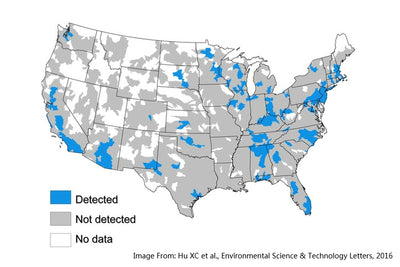Stephanie Angione, Ph.D.
Updated 1/29/2020 to include new data.
What Are Perfluoroalkyl and Polyfluoroalkyl Substances (PFASs)?
Fluorinated substances include a diverse range of chemical compounds that all contain at least one fluorine (F) atom. These substances vary in the amount of fluorine atoms they contain, and those that are highly fluorinated, or contain many F atoms per carbon (C) atom are referred to as perfluoroalkyl substances. These highly fluorinated substances are unique in their hydrophobic (water repellent) and lipophobic/oleophobic (fat/oil repellent) properties, as well as their general chemical and thermal stability.
These properties have made PFAS substances common in many types of applications, including creation of non-stick cooking surfaces, stain and water resistant coatings on fabrics, creation of oil/fat resistant food packaging and also in foam materials used to fight and prevent fires. Additionally, the automotive, aerospace, and construction industries have widely used these fluorinated substances for various applications due to their low friction properties.
Common PFASs include perfluorooctanoic acid (PFOA) and perfluorooctanesulfonic acid (PFOS), which have been used in the production of Teflon and Scotchgard respectively. The manufacturer 3M phased out the production of PFOS in 2002 and the EPA helped manufacturers of PFOA phase out production completely in 2015.
How Do PFAS Substances Contaminate the Environment?
PFASs are deemed “emerging contaminates” by the EPA; meaning that they are chemicals or materials thought to pose a potential threat to health and the environment, but haven't yet been regulated. PFASs contribute to environmental contamination largely due to the fact that they are highly resistant to degradation processes, and thus persist for many years in water, air and can enter the food chain via bioaccumulation in certain animal species.
The primary sources of human exposure to PFAS include:
- Consumption of contaminated drinking water
- Consumption of food that is packaged in materials containing PFASs, which have included fast food containers, microwave popcorn bags. (Most food manufactures have stopped using PFASs in these types of packaging.)
- Consumption of food that contains PFASs, including fish and shellfish
- Contact (hand to mouth) with clothing, carpets or other fabrics that have been treated with PFASs. (Skin exposure to PFASs on their own does not cause significant absorption into the body.)
What Are the Health Effects of PFAS?
The discovery of persistent contamination of drinking water sources with PFOA in West Virginia and Ohio prompted a large epidemiological study called the C8 Health Project. The study included nearly 70,000 individuals who had elevated PFOA levels in blood – approximately 500% higher than the representative population. The study found statistical correlation between elevated blood concentrations of PFOA with ulcerative colitis, impaired thyroid function, high blood cholesterol, testicular cancer, kidney cancer and preeclampsia.
How Do Polyfluoroalkyl & Perfluoroalkyl Substances Contaminate Drinking Water?
In 2016 the EPA released a lifetime health advisory for PFOA and PFOS in drinking water. This advisory indicates that the individual or combined concentration of PFOA and PFOS in water should be less than 70 parts per trillion (ppt). This EPA guideline is not an enforced limit – it simply provides guidance to local public health officials. However, under EPA guidelines issued in 2012, water systems are required to monitor levels of PFOA and PFOS. The results of this monitoring effort can be found on the National Contaminant Occurrence Database. Together with data collected under the monitoring effort and established assessments of human health effects, the EPA will make a regulatory determination to include PFOA and PFOS in national drinking water regulations.
Communities that have sources of drinking water contaminated with PFASs are typically localized and associated with a specific industrial facility or area used for firefighting. Both PFOA and PFOS have been found in drinking water systems due to this kind of localized contamination. A 2016 study of drinking water in the U.S. found unsafe levels of PFASs at the EPA minimum level of 70 ppt in 194 out of 4,864 water sources in 33 states. More recently, a 2020 study has shown that PFAS contamination is more widespread than originally thought. Water sources with the highest levels of PFAS contamination were near industrial sites and military bases, and one of the major contributing sources was found to be firefighting foam.
How Can I Remove Polyfluoroalkyl & Perfluoroalkyl Substances From My Drinking Water?
Some public water systems employ methods (like granulated or powdered activated carbon) to reduce PFOA and PFOS at the municipal level, but these systems do not remove shorter-chain PFAS, like GenX. Hydroviv water filters use a blend of highly-porous active media including carbon, specialized ceramics, and ion exchange media to provide broad protection against PFASs (short and long chain) from drinking water (3rd party test reports for Hydroviv products can be Viewed HERE and HERE) . Water filtration systems that use reverse osmosis systems can also be effective, but you'll want to contact the manufacturer and ask for 3rd party test results against PFAS (not just PFOA/PFOS, which are easy to filter).
Hydroviv makes it our business to help you better understand your water. As always, feel free to take advantage of our “help no matter what” approach to technical support! Our water nerds will work to answer your questions, even if you have no intention of purchasing one of our water filters. Reach out by dropping us an email (hello@hydroviv.com) or through our live chat. You can also find us on Twitter or Facebook!
Other Articles We Think You'll Enjoy
5 Things You Should Know Before Purchasing A Reverse Osmosis Filter For Your HomeHow You Can Filter Chromium 6 From Your Drinking Water
How Does EPA Determine Allowable Levels Of Toxic Chemicals?





